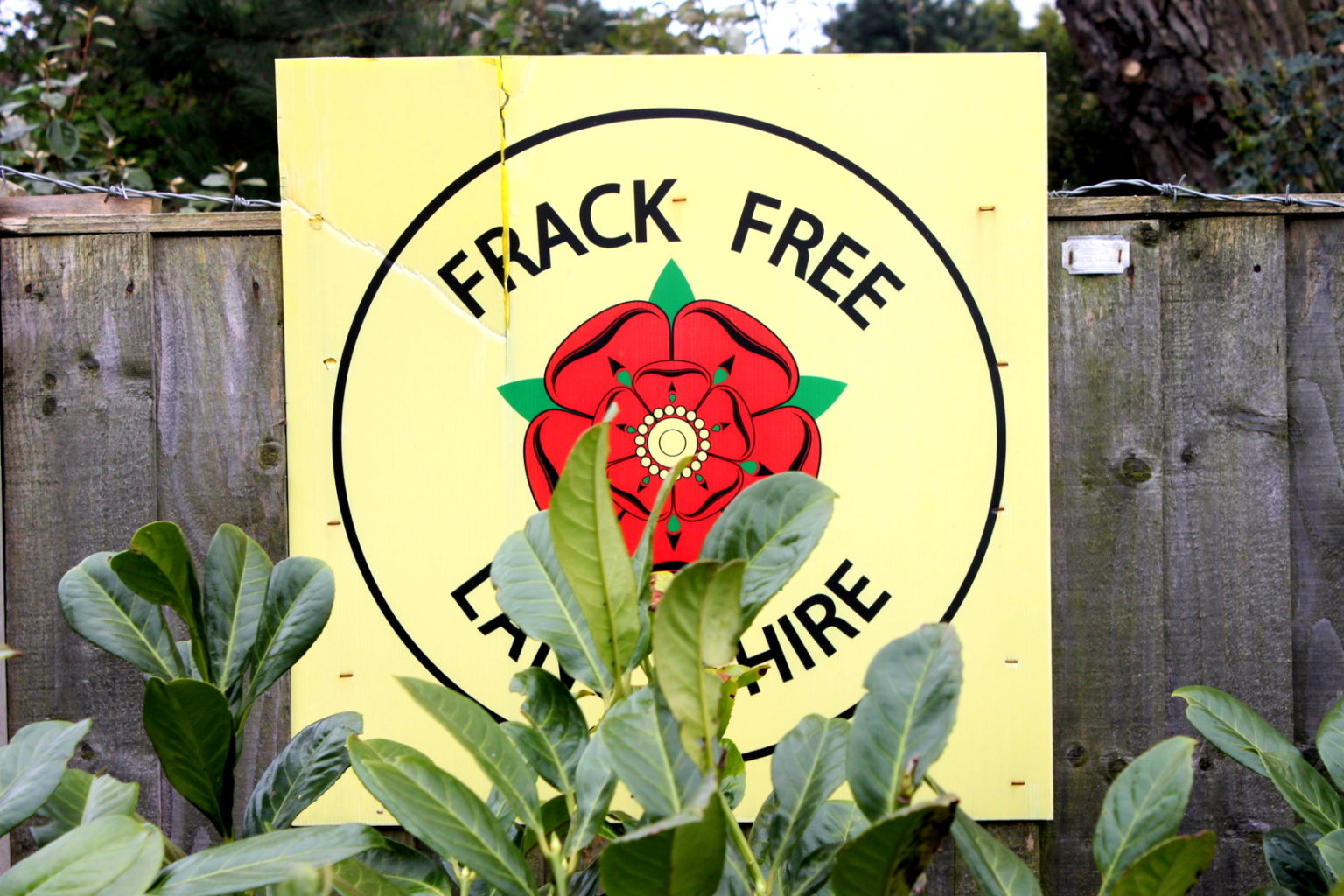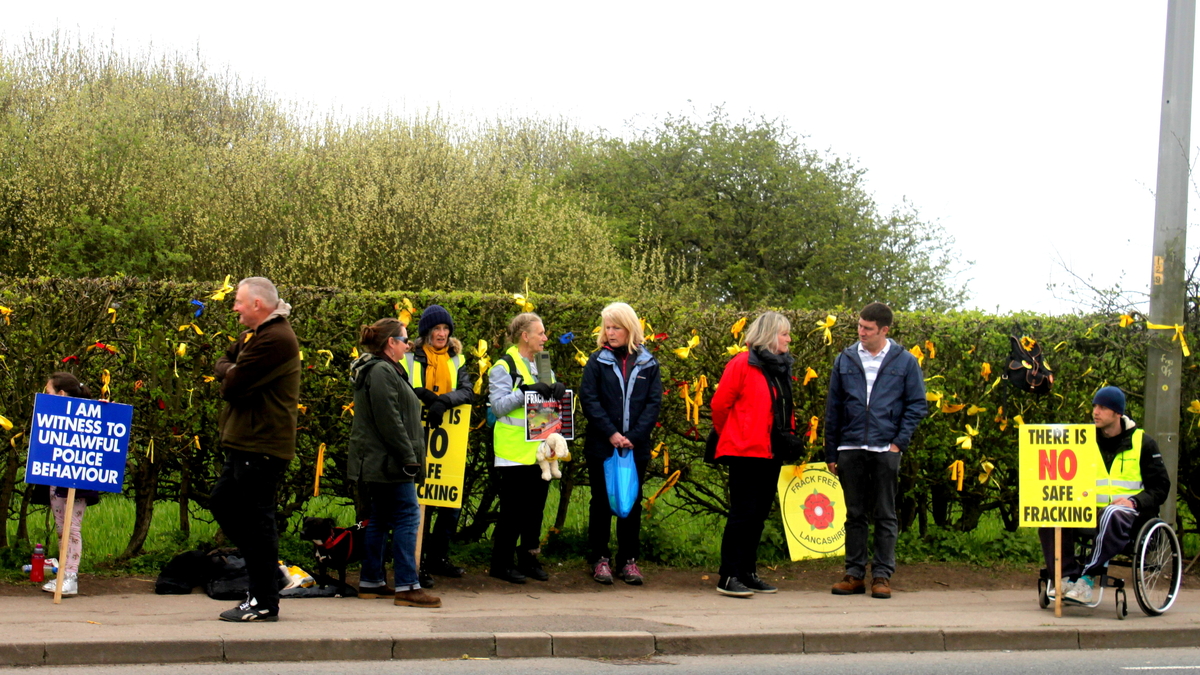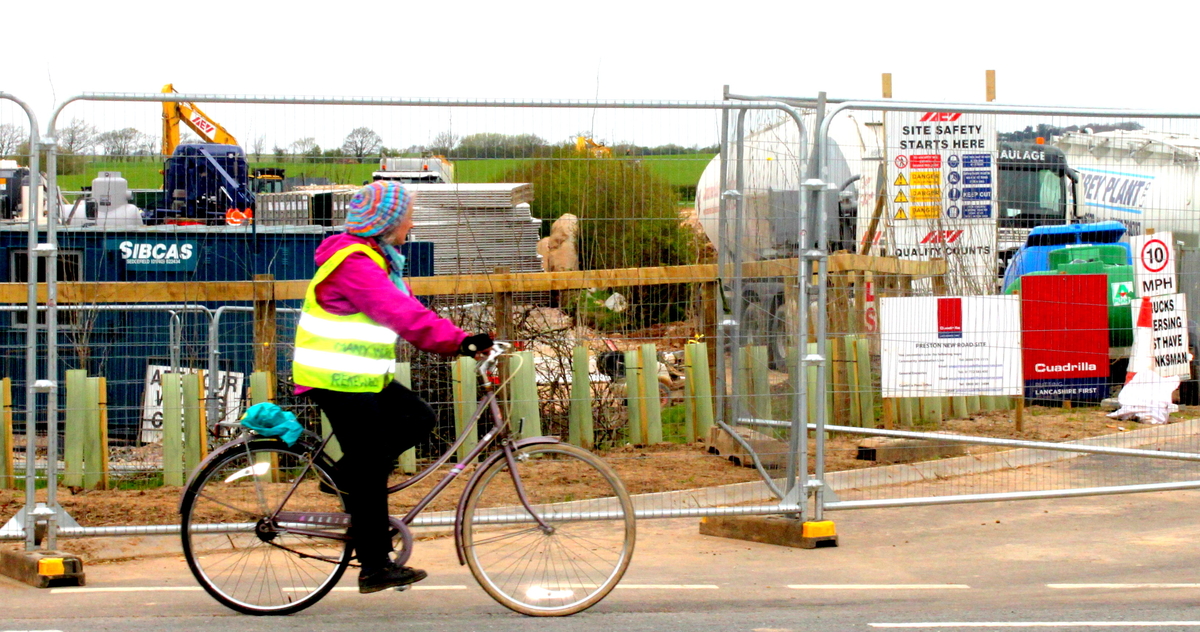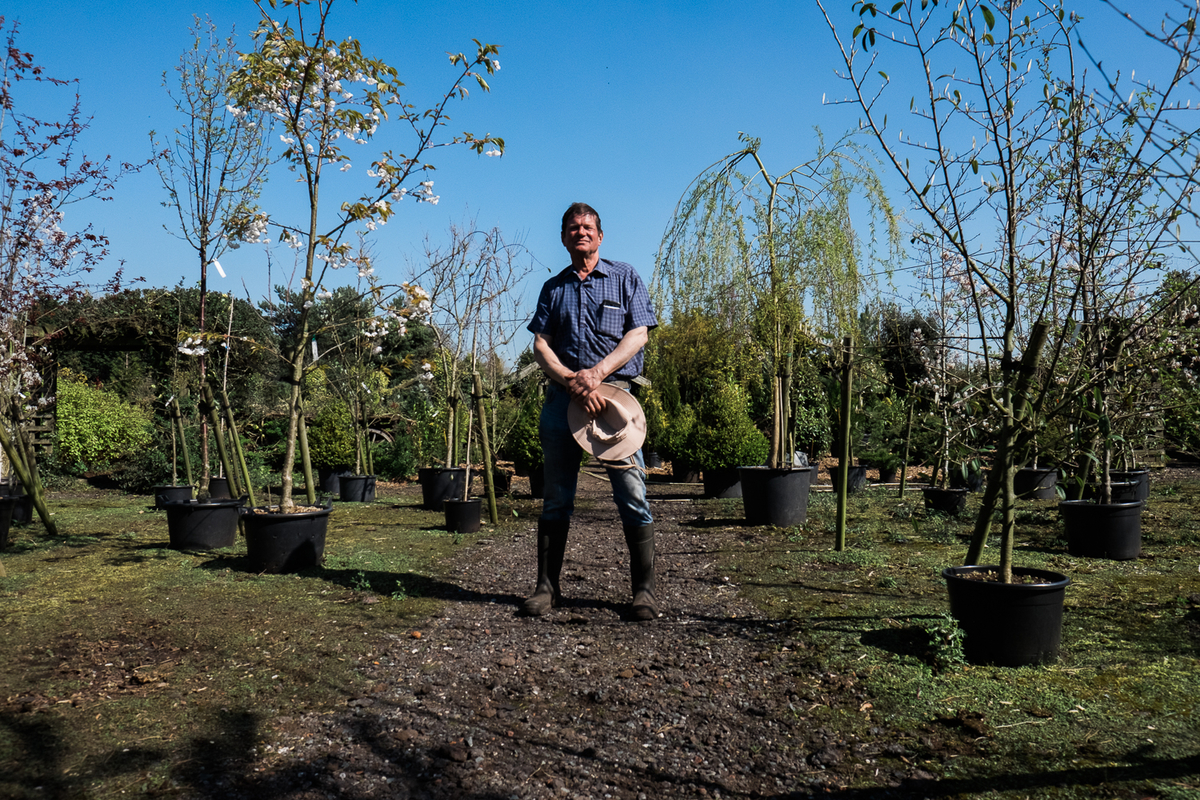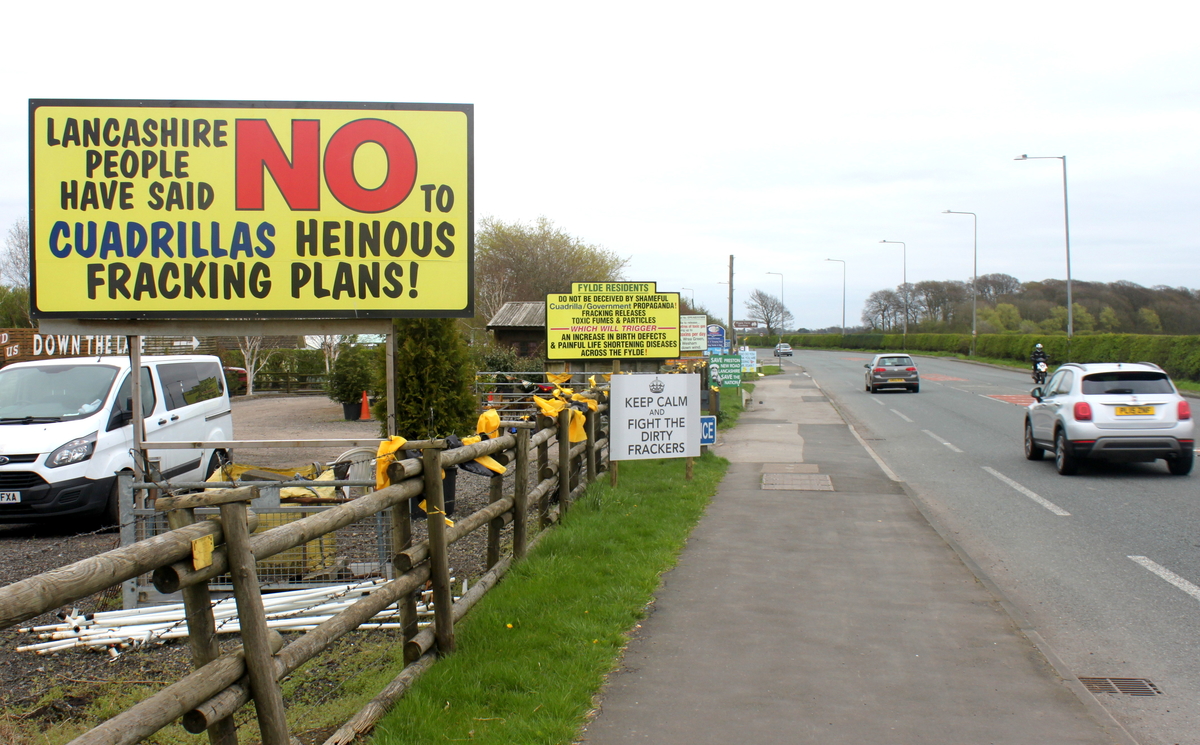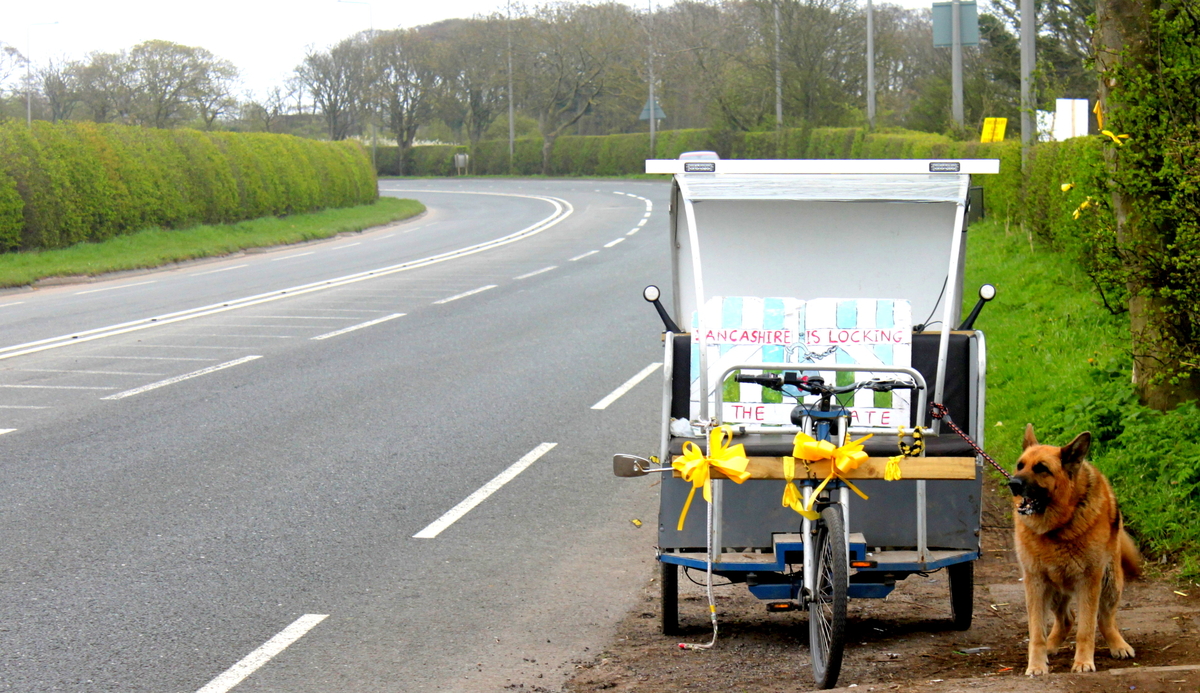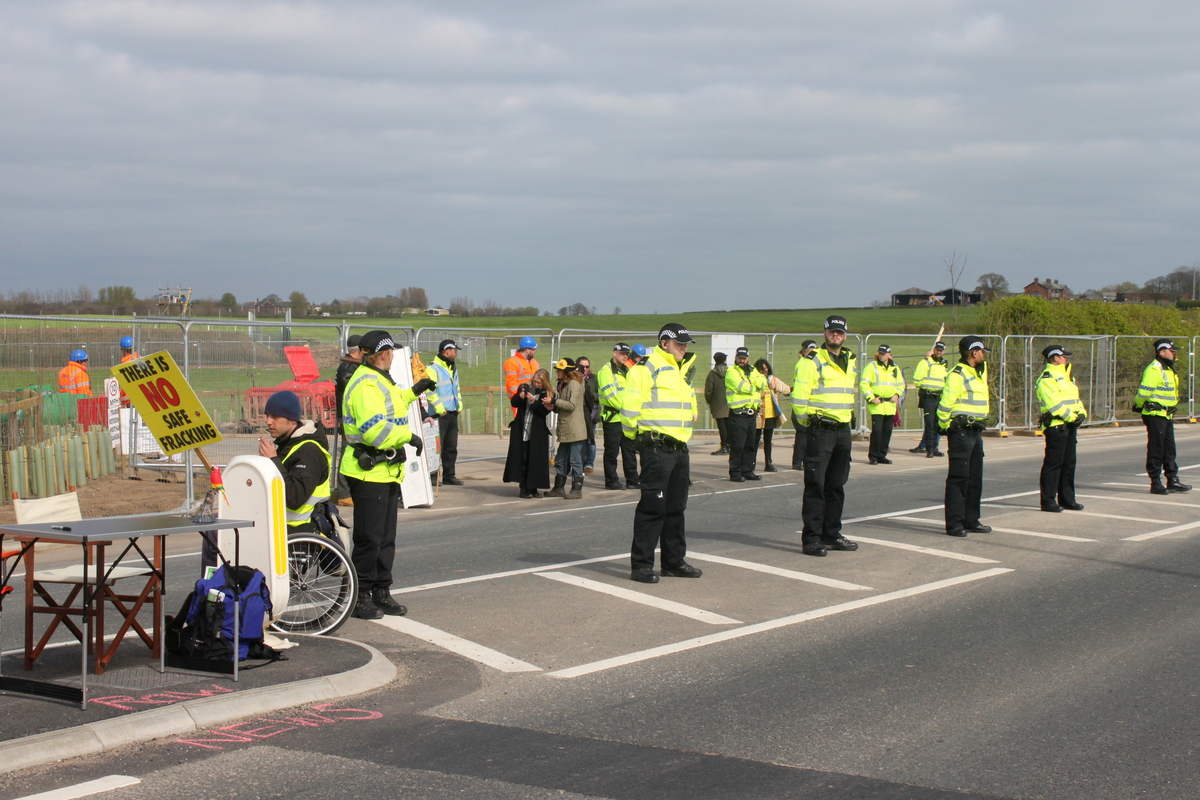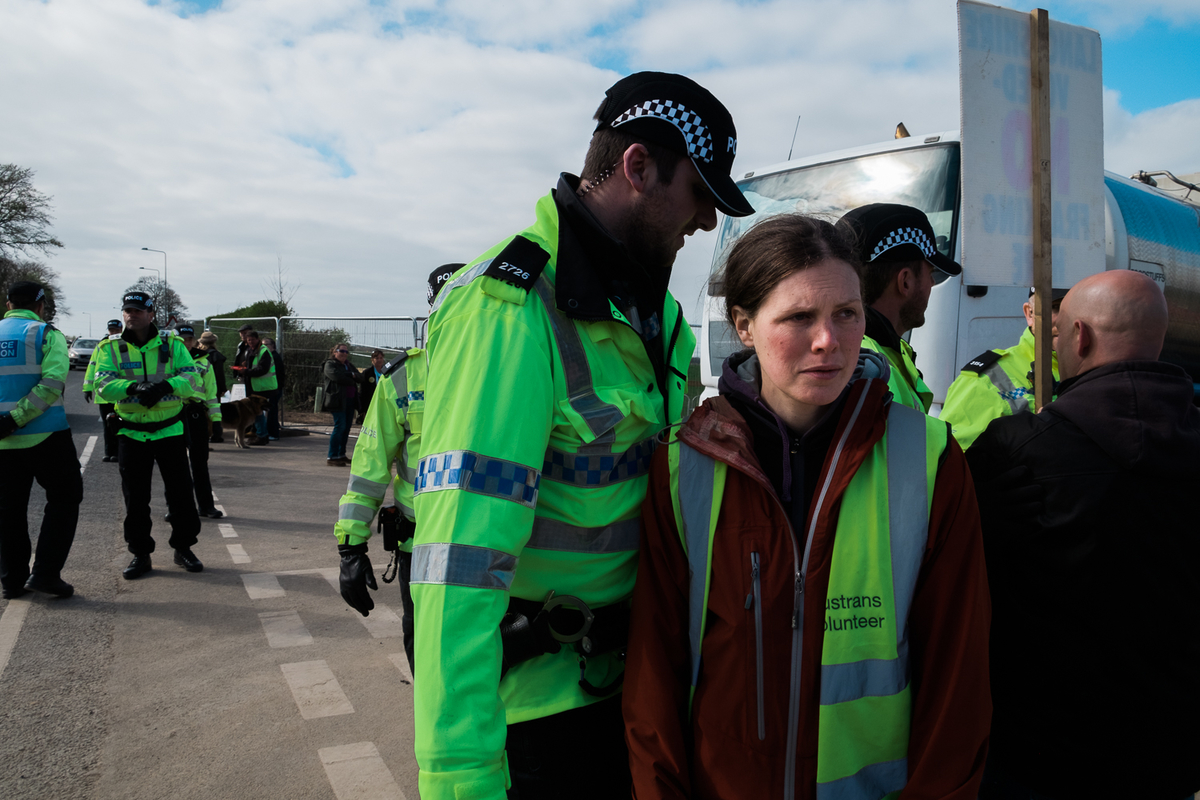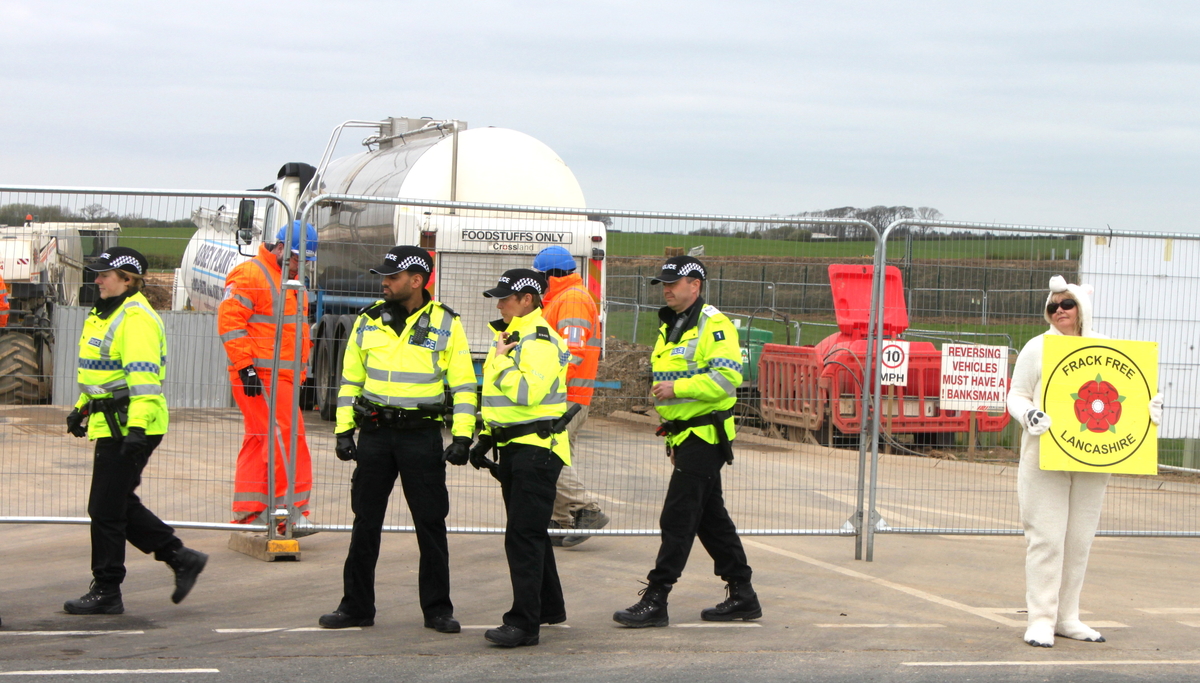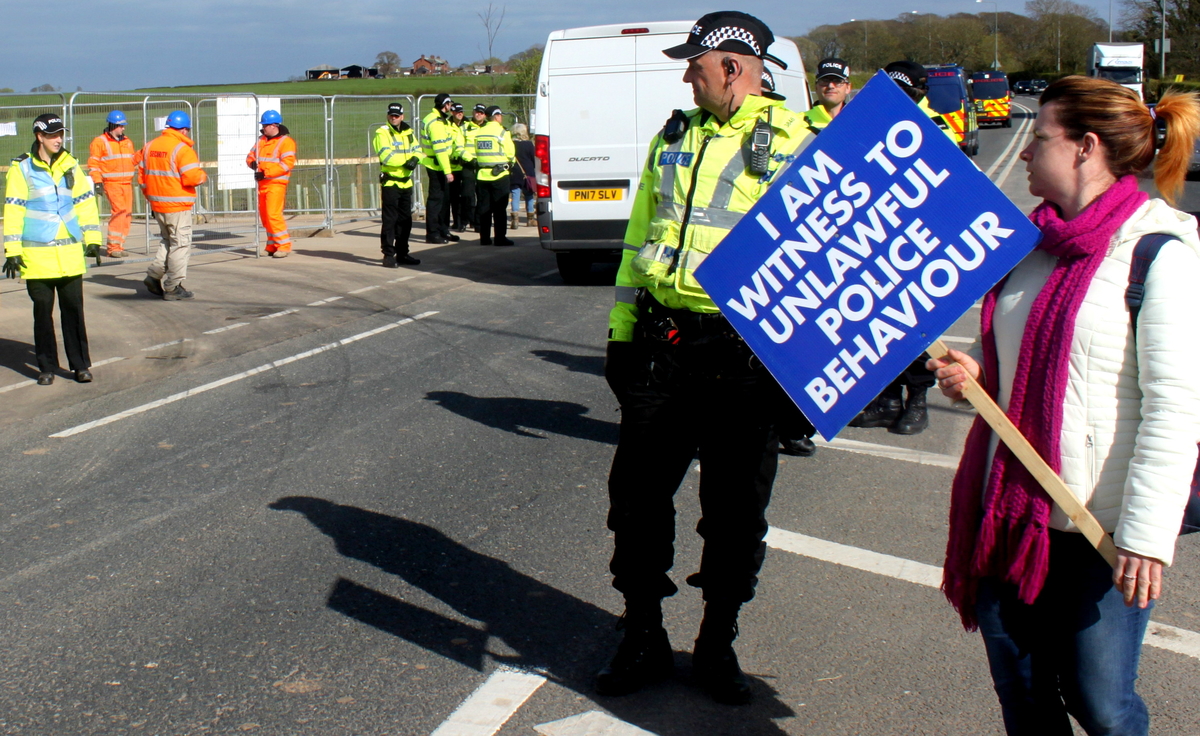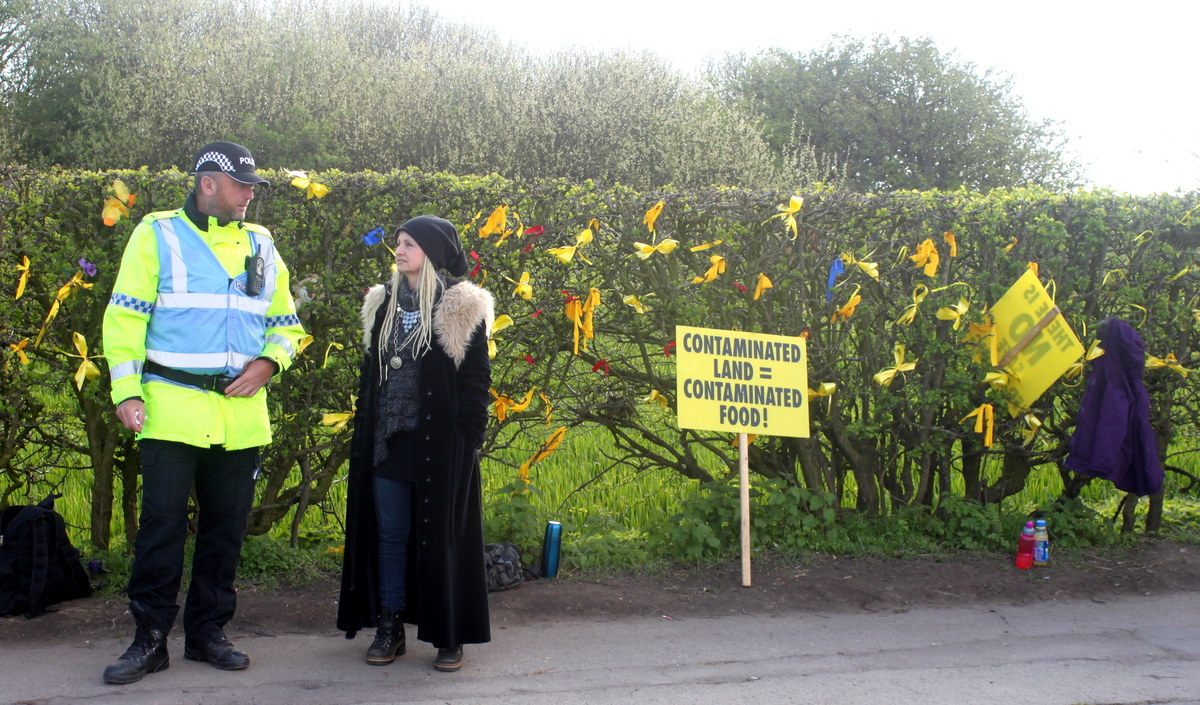“There’s something happening,” Nick tells me. “There’s a pattern to it”.
He says this a lot. He’s always right.
Nick Sheldrick is eagle-eyed. He’ll be the first to spot the policeman with red pips on his shoulders chatting feverishly into a walkie talkie, the blue-vested “liaison officers” coordinating with security, and the special forces with “evidence gathers” emblazoned on the vests dragging their camera and tripod up the road.
Nothing within this 25 metres of road goes unnoticed by Nick and his fellow protesters: how the fence has been extended, which police officer is first to the gate, or when a row of stumpy new-growth shrubs suddenly appears at either end of the wired division, allegedly to push the protesters further back into the road.
Maybe that’s because, most of the time, there’s nothing much to do but watch.
This is the Preston New Road anti-fracking protest. And the protesters have been here for 65 days now.
“We all have a chat and hear each other’s life stories, and how each other got here. There’s a mixed bunch of people from all sorts of lives,” Nick says.
“We get people come past shouting ‘get a bath’ and ‘get a job’. They think we’re all activists, pro-activists, but we’re not. We’re local people that said ‘no’.”
You wouldn’t necessarily know it to from the press coverage.
The national media tends to focus on the court cases and the arrests. The local press mainly reports on how the protest affects traffic and the participants’ occasional PR stunt.
I have driven 250 miles from London – a place where people in suits sit in leather-chaired rooms to discuss the economic implications of the UK’s fledgling shale gas industry – to find out who the protesters are, and what motivates them to turn up day after day in freezing wind and horizontal rain.
Numbers vary, but on quiet days there are about 20 people lining the road at a time. They are all white and there are noticeably more women than men. Their ages trend north of 40. They look more like supporters cheering on family members in a village fun-run than political agitators.
In an area of England where the dominant Spring colours remain stubbornly brown beneath slightly-greener brown, the protesters wear fleeces, they hold placards, they occasionally sing. But most of all, they chat: about the police, about the day before, about the weather, about Fylde, about who did what, when and where. And they chat to me.
At the end of two days, two notebooks, and two tanks of petrol I have a story about what happens when a central government tells local people what to do, what happens when the police protect profit and not people, and what happens when 25 metres of sleepy countryside roadway gets turned into a symbolic battleground for a whole country’s energy debate.
Because, hard as it may be to believe, this is England’s fracking frontline.
‘Fairtrade Fylde’
As you drive into Little Plumpton from the Preston end, it’s hard to miss the signs declaring the area a “Fairtrade” region. But as far as the protesters are concerned, Cuadrilla’s activities are anything but fair trade.
Since 2011, Cuadrilla has been trying to frack Lancashire. The company is at the vanguard of an industry that for almost a decade has failed to get off the ground.
There have been false starts. The government put a moratorium on fracking tests in 2011 after a tremor was detected at one of Cuadrilla’s other sites near Blackpool. The temporary ban was lifted in late 2012, but the industry has struggled to recover.
On January 4 2017, after the Communities Secretary Sajid Javid overturned the local council’s opposition to Cuadrilla’s plans, the trucks moved into the Preston New Road site. They were met by dozens of local people, angry that their will was not being done. And the Preston New Road protest was born.
I visit the protesters for two days, on April 6 and 7, during a bracing Spring. It has been months since the protesters first gathered. The day before I arrived is one that the protesters repeatedly describe as “the hardest yet”. And, just a few days after I leave, they will lose their last realistic litigious means of stopping Cuadrilla — a judicial review of the government’s decision to overrule Lancashire County Council.
On that day, April 12, a high court judge ruled against an a protester’s appeal that Cuadrilla’s plans failed to properly consider the climate impacts of shale gas extraction. The court’s decision means Cuadrilla is now free to test up to four wells at its Preston New Road site — a decision Cuadrilla’s CEO Francis Egan told the press the company expected.
The site is tucked away in England’s north west, an area once described as “desolate” by a Conservative peer arguing for companies’ right to frack the region’s countryside.
As you approach the site by car, there is nothing for miles, then a few signs telling people to “Google ‘fracking and health’”. Half a minute beyond that, and there are more signs: advisory speed limits due to possible obstructions in the road.
A moment later, there is the protest; a small gaggle of people on one side of the road, holding placards, standing next to a thick, spiky hedgerow adorned with yellow ribbons — the colours of one of the protest groups, Frack Free Lancashire, I am told.
Cuadrilla’s site is on the other side of the wide, single lane road. It is unimpressive. It looks like it could be the start of a new housing development. It is currently fairly well hidden in a slight valley, though more will be visible when the drilling rigs are erected.
There are a few trucks, a few people in high-viz jackets, the odd white or red hard-hat bobbing amid mounds of mud and rubble. A couple of small signs with Cuadrilla’s logo give the site away, but you only see them if you are really looking.
Cuadrilla has leased the land from a dairy farmer: Mr Allan Wensley.
The protesters regularly refer to Wensley as “the most hated man in the village”, but while there is some scorn, there is mainly pity.
He has been sold a dud, the protesters tell me. He’s barely getting any money, they claim. He’s getting all this hassle, and — by hook or crook — this is not going to happen anyway, they say.
Wensley rarely speaks to the press. In one of his only interviews, he told The Times he does not regret his decision to lease Cuadrilla the land, for which he gets paid £30,000 to £50,000 a year, the newspaper speculated.
Wensley could not be reached for comment on this story. Cuadrilla would not confirm or deny the figure.
Wensley has a security guard parked outside his house around the clock, who only briefly leaves the shelter of his car when I get a little too close for comfort with my camera.
At the other end of the village to Wensley’s farm is Maple Farm. You cannot miss Maple Farm as you pass through Little Plumpton, adorned as it is with dozens of anti-fracking signs.
Maple Farm is in fact not a working farm, but a nursery selling all manner of trees and shrubs. It is owned by John Tootill.
There are normally six or seven slightly scruffy, sometimes camo-wearing, occasionally dreadlocked people hanging around Maple Farm’s car park. These are not John’s normal customers, but they are people he has welcomed with open arms.
He lets a handful of campers that have come from elsewhere use his facilities, park there, and meet in his grounds. He sometimes gives people that can’t walk the half mile or so from the nearest parking spot lifts to the site in his big, black truck.
He is a stocky five foot ten and tanned, as you’d expect from a man who spends most of his life outside. He rarely gets involved in scuffles. He is unfailingly polite.
He’s at the protest often, rarely for long, but he’s almost always the first to arrive.
I arrive at the site around 6:30am on my second day in Little Plumpton. Despite this causing some consternation among Cuadrilla’s site management (“do you know something we don’t?”), all is quiet.
At about 7am, I see a stocky, tanned man on a blue tricycle. A large Alsation trots happily beside it. The tricycle has a wagon. In the wagon are dozens of placards.
This is John, doing what he does every morning at about 7am.
He parks his tricycle in a slight indent in the road. The same indent a police van parked in the day before, I notice. The tricycle will stay all day. The police van will have to find somewhere else to perch.
John stalks the pavement, planting placards in the hedgerow as if they were national flags on newly discovered land.
The council once took him to court in an effort to get him to remove his imaginative anti-fracking artwork. He resisted. The case was eventually dropped.
He stops to talk. He is friendly, if not entirely willing. This is not because he doesn’t want to talk — he definitely does — but it’s because he doesn’t think he can talk eloquently about an issue he cares so much about, or for a diverse group of people he spends so much time, effort and resources helping.
John’s main concern is the toxins fracking will bring due to methane flaring and other pollutants associated with the gas extraction process. He’s worried about what that will do to the air quality on his land when the prevailing wind shifts direction. He’s worried about the aquifers.
He’s worried about his family, his livelihood, his village.
More than this, though, John is worried about the way Cuadrilla has gone about its business.
“It’s a complete travesty that this can happen in this day and age,” he tells me.
“All the protesters have been peaceful and good humoured, but there has been some bad behaviour by the police.”
“The police say they’re facilitating protest, but they’re working almost exclusively for Cuadrilla,” he claims. “As a result, ordinary people are losing respect for the police.”
At one point, John describes to me what it is like to be “shuffled” out the way by the police. What I see as a gentle hand maneuvering people is, he says, much more than that.
As he demonstrates, palming my side in what is effectively a shove without any air between initial movement and contact, I almost fall sideways into the hedge.
Credit: Alban Grosdidier / Hans Lucas
Getting Tough
This is the protesters’ newest, greatest, concern. What started as an anti-fracking protest has become a tale of local people trying to enact their right to quietly resist publically-funded forces abetting a private enterprise.
A few days before I arrive, the BBC reports that it costs £450,000 each month to police the protest. Both sides have taken this number to heart.
The protesters say that it is a waste of money, that it is unnecessary, and that they are there to be annoying — “a nuisance” — but not to do anything illegal. Pro-fracking groups agree that it is a waste of money, but argue instead that it shows the police commissioner needs to “get tough” on the protesters.
Among the small crowd that the police constantly surveil is Miranda Cox, a local councillor and, until recently, very much not a protester.
“Protest is a new thing for me, but I’ve never seen a more generous bunch of people,” she tells me. “We all have a common cause, even if we do have a different way of approaching it.”
She is middle-aged, cheerful, and kind. She laughed at me shivering in my inappropriately light clothing shortly after I arrived, and told me where to purchase a new layer or two and a hot cup of tea.
She has become what some might call “radicalised”, but is probably better described as fed-up.
She is fed-up of local people being ignored, fed-up of seeing her friends mistreated by police, and fed-up that no matter how many days she returns to the same 25 metres of road, nothing seems to change.
“I’m just so cross on so many issues,” she tells me — from the lack of a wheel wash for the trucks leaving the muddy site, to the way the fencing appears to keep inching forwards.
“All these regulatory bodies aren’t doing their jobs. They’re not here to see it.”
There are plenty more standing at the side of the road like Miranda.
Jo Bignold, a polite, middle class, middle-aged woman from down the road, offers me a purple anorak as I shiver. “I’m not a protester,” she tells me, holding her placard at waist height.
There is Sarah Jacques, pronounced “Jakes”. She was a Tory voter once. She is currently deputy mayoress of Fylde. Like Miranda and Jo, “protester” comes quite a long way down the list of ways she would have described herself a few months ago. But now she is here regularly, keeping an eye on the police, and trying to stop Cuadrilla.
While there are some protesters from out of town that are willing to test the police’s resolve, often referred to as “protectors”, most people I meet are like Miranda, Jo and Sarah. On the two days I am there, these are the people it is costing Lancashire taxpayers £450,000 each month to police.
It’s easy to see why it costs so much.
Every time a lorry arrives, the police file out of their vans, one at each end of the road. They stand in a phalanx, sometimes two rows deep, sometimes only one.
The protesters know the pattern. They know this means something is coming. So they cross the road. Sometimes a group of five, sometimes 10.
A truck arrives carrying water, fence panels, a new digger, or — the protesters’ current favourite — aggregate needed to turn the mud pit into a concrete frack pad.
The lorry comes down the single lane highway with one police van in front, one behind.
The leading police van speeds up and away. The lorry slowly turns left. The protesters wave placards. They shout “shame on you”. They grab their phones and live stream images across the globe of a lorry slowly entering a construction site.
There is noise, but not much else.
While they are doing this, the police shuffle them aside. Sometimes putting hands on them, sometimes politely asking, always making sure they move.
Then the gates close. The police go back to their vans, engines running. The protesters re-cross the road to the relative shelter of the hedgerow. The placards are perched back on the hedge. The chatter starts again.
“All this, for some fencing,” Miranda murmurs.
The protesters really want to “slow-walk” the lorries — picking the deliveries up a half-mile or so down the road and slowly escorting them to the site. That would allow them to stall the trucks and limit the number of deliveries that can be made each day, delaying the construction process.
The protesters hope those delays could deter suppliers from dealing with Cuadrilla, and buy them some time to find other ways to stop the project.
They say they should be allowed to slow walk the lorries under articles 10 and 11 of the Human Rights Act, which give them the right to freedom of expression, and freedom of peaceful assembly and protest. They claim the police are using article 2 of that law to prevent them, which imposes an obligation on the government to protect the lives of citizens — effectively giving them license to stop the protesters doing anything that could end with them hurting themselves.
When I ask for clarification, all the police tell me is that they prohibit slow walks because “it is simply not safe on a busy road used by the public with a 50 miles per hour limit”.
With the options for disruption limited at Preston New Road, campaigners have taken to targeting Cuadrilla’s suppliers.
The day I leave, local radio reports that 11 protesters associated with campaign group Reclaim the Power have been arrested for blocking the entrance to drilling company PR Marriot’s Chesterfield headquarters, 130 miles away. As far as I can tell, none of the Preston New Road protestors were involved in the action.
The Preston New Road police are reluctant to speak to me on the record. But I have multiple friendly conversations with the police liaison officers, who are technically separate from the operational support units that have been specially deployed to the protest.
The liaison officers are a constant presence, and have a jovial if somewhat superficial relationship with the protesters. Most have been there for the majority of the time the protesters have been on the side of the road. One has been ever-present, I am told.
They try to cajole rather than force the protesters to move out of the way, asking the protesters to stick to their pledge to be a nuisance rather than anything more. They seem to have a lot of empathy with the protesters, even when they are called “spies” and “thugs”.
Mainly, they seem cold and bored. They acknowledge the goldfish bowl effect the small strip of road appears to be having on everyone’s mental state, including their own.
Credit: Alban Grosdidier / Hans Lucas
A New Phase
The constant confrontation with the authorities is grinding Miranda down. Like many others, Miranda is tired. Very tired.
She doesn’t make it to Preston New Road on my second day. When I get back to London, she’s emailed, apologising. She wasn’t there “because of everything that has happened this week”.
That was a line I heard a lot. “This week” had been a tough one. “This week” had been draining.
So, what happened “this week?”
The day before I arrive, Wednesday April 5, was “brutal”, they tell me. It was a “swap work for work” day; essentially encouraging people to take a day of leave to join the protest. And they did.
Because of the increased numbers — a few hundred I am told, compared to the 20 to 30 I see on the days I am there — the police were out in greater force than usual.
It was bad tempered and ugly, the protesters say. Lots of people were kettled, many of them attending Preston New Road for the first time. I hear time and again of someone that ended up in hospital due to police treatment.
The only press coverage of the protest that day was a small piece in the local Blackpool Gazette, which reported traffic tailbacks due to “protesters in the road” and that “a man in his 20s suffered a suspected leg injury” and was taken to hospital.
Lancashire Constabulary tells me that anywhere between 25 and 100 police are deployed daily to cover the protest. On the days I am there, it seems closer to 25, with maybe another 20 on standby in vans up and down the road. On Wednesday, the police tell me 62 officers were deployed.
The police declined to give me specific details or arrest numbers for Wednesday April 5. But the difference between the scenes that can be seen on Facebook – the protesters live stream almost every moment of every day – and what I saw in my two days in Little Plumpton could not be more pronounced.
Tales of “the Wednesday” are repeated to me so many times, independently, by so many people, that it’s clear this was a phase-shift for the people lining the edge of Preston New Road.
While arrests had been made before, the protesters are now expecting this increased level of police attention, and are acting accordingly.
I watch for two days as eight police closely watch Nick roll across the road in his wheelchair accompanied by a woman dressed as a polar bear, as police seize a bike called Clarissa from a man supposedly obstructing a heavy goods vehicle by cycling alongside it, and as 30 police return to their vans having successfully guided a truck past Ricky the labrador who wags his tail at everyone, no matter their views on fracking.
It often looks ridiculous and, on those two days, it’s hard to imagine how much tougher the police could legitimately be.
Hidden Frontline
The protesters arrived in January because they didn’t want Cuadrilla to frack. It was a battle they had already been fighting for six years: in the council, in the courts, through all the litigious channels citizens have available to them.
But now they have been on the side of the road for three months, their motives have evolved.
The protesters I meet told me they were there because they were being ignored. Because they were disenfranchised. Because a government that is supposed to represent them was playing deaf.
Fracking was rarely mentioned when I was there. Climate change was mentioned once.
Despite the generally jovial atmosphere, the Preston New Road protesters are cracking. They are being battered: by the wind and rain, sometimes by the police, and repeatedly in the courts. They carry the weight of a nation’s efforts to prevent fracking on their shoulders, without much help.
There are some of their number that are not local. I meet LogicAl and a “cuckold clan of gypsy activist tree huggers”, as he identifies them to me. LogicAl did once manage to climb on a lorry — “a fucking rush mate” — and this group occasionally disrupts the site in other ways which gets them arrested.
A couple of them, such as Tina Rotheray and Gayzer Frackman, can be seen at various actions across the country and have taken on the mantle of spokespeople for the movement. A movement that is becoming fractured as patience wears thin and Cuadrilla, lorry-by-lorry, continues to build.
But most of the protesters I see are local people trying to prevent something they didn’t ask for, that their council voted against, and which is happening anyway.
After more than three months inhaling diesel fumes and dust, extreme caution — maybe even paranoia — has set in.
The protesters see minor moments inside the site as potentially match-winning: a man without a hard hat, a lorry reversing without a guide, the site manager driving a few yards with no hands on his steering wheel as he waves to his ever-present adversaries.
Likewise, the police have begun to interpret everyday actions by the protesters as breaches of some delicate peace: two police flank a protester walking 15 minutes down the road towards the nearest toilet, officers whose only job is to collect visual data on the protesters film a trestle table set up on a traffic island, and three police surround a retired woman in a vest adorned with hand-drawn wind turbines to ensure she doesn’t take up too much room in front of an eight metre wide gate.
A million minor dramas played out over the two days I spent standing at the side of Preston New Road. Most of them physically unimportant beyond the 25 metres of tarmac that has become these people’s entire world, but scenes that could still prove symbolically crucial.
This is no longer just about fracking. This dispute is now about London versus the North. It is about the government failing “the people” from which it is becoming increasingly detached. It is about people sensing hopelessness and helplessness and trying to find a means to resist.
These are familiar narratives.
The handful of protesters on Preston New Road are on the frontline of a national effort to prevent the shale gas industry getting a foothold in the UK, an industry that more than twice as many people in the country reject as support.
As the recent High Court decision in London confirms, the local people lining this highway between Preston and Blackpool fighting the fight are — largely quietly, largely out of sight, largely peacefully — losing. Nonetheless, they promise they will still be there tomorrow.
Photo credits: Mat Hope / DeSmog UK CC 2.0 unless otherwise stated. Also thanks to Alban Grosdidier / Hans Lucas for their photo contributions (as credited).
Subscribe to our newsletter
Stay up to date with DeSmog news and alerts


